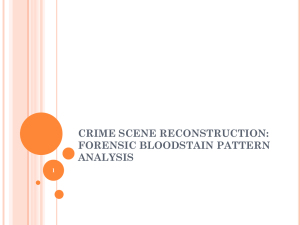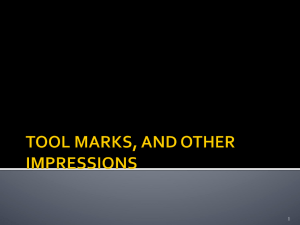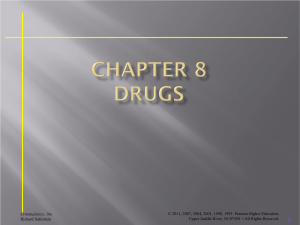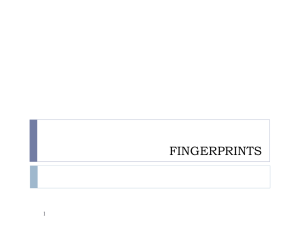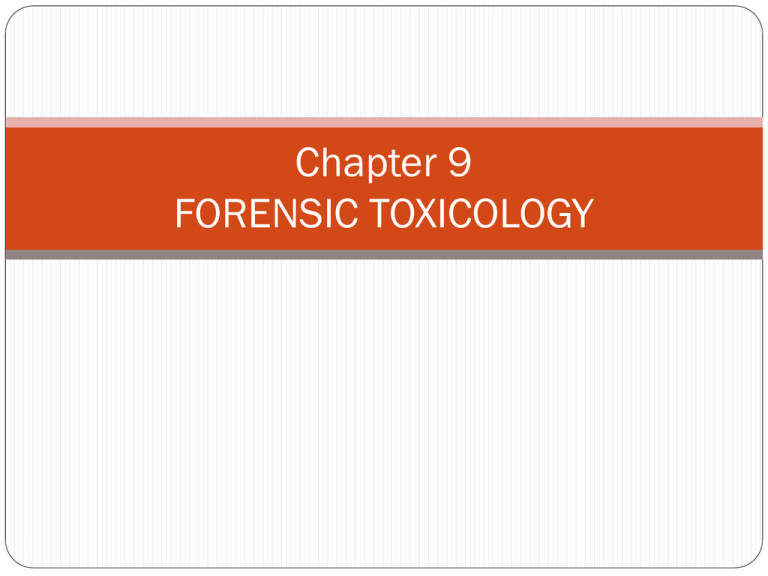
Chapter 9
FORENSIC TOXICOLOGY
1
Introduction
Toxicologists are charged with the responsibility for
detecting and identifying the presence of drugs and
poisons in body fluids, tissues, and organs.
Toxicologists not only work in crime laboratories and
medical examiners’ offices, but may also reach into
hospital laboratories and health facilities to identify a
drug overdose or monitor the intake of drugs.
A major branch of forensic toxicology deals with the
measurement of alcohol in the body for matters that
pertain to violations of criminal law.
2
Criminalistics, 10e
Richard Saferstein
© 2011, 2007, 2004, 2001, 1998, 1995 Pearson Higher Education,
Upper Saddle River, NJ 07458. • All Rights Reserved.
9-
Toxicology of Alcohol
The analysis of alcohol exemplifies the primary objective of
forensic toxicology—the detection and isolation of drugs
in the body for the purpose of determining their influence
on human behavior.
Alcohol, or ethyl alcohol, is a colorless liquid normally
diluted with water and consumed as a beverage.
Like any depressant, alcohol principally effects the central
nervous system, particularly the brain.
3
Criminalistics, 10e
Richard Saferstein
© 2011, 2007, 2004, 2001, 1998, 1995 Pearson Higher Education,
Upper Saddle River, NJ 07458. • All Rights Reserved.
9-
Alcohol Levels
Alcohol appears in the blood within minutes after it has been taken
by mouth and slowly increases in concentration while it is being
absorbed from the stomach and the small intestine into the
bloodstream.
When all the alcohol has been absorbed, a maximum alcohol level
is reached in the blood; and the post absorption period begins.
Then the alcohol concentration slowly decreases until a zero level
is again reached.
Factors such as time taken to consume the drink, the alcohol
content, the amount consumed, and food present in the stomach
determine the rate at which alcohol is absorbed.
4
Criminalistics, 10e
Richard Saferstein
© 2011, 2007, 2004, 2001, 1998, 1995 Pearson Higher Education,
Upper Saddle River, NJ 07458. • All Rights Reserved.
9-
Alcohol Levels
Elimination of alcohol throughout the body is
accomplished through oxidation and excretion.
Oxidation takes place almost entirely in the liver, while
alcohol is excreted unchanged in the breath, urine, and
perspiration.
The extent to which an individual may be under the
influence of alcohol is usually determined by either
measuring the quantity of alcohol present in the blood
system or by measuring the alcohol content in the
breath.
Experimental evidence has verified that the amount of
alcohol exhaled in the breath is in direct proportion to
the blood concentration.
5
Criminalistics, 10e
Richard Saferstein
© 2011, 2007, 2004, 2001, 1998, 1995 Pearson Higher Education,
Upper Saddle River, NJ 07458. • All Rights Reserved.
9-
Alcohol and Circulatory System
Humans have a closed circulatory system consisting of a
6
heart, arteries, veins, and capillaries.
Alcohol is absorbed from the stomach and small intestines
into the blood stream.
Alcohol is carried to the liver where the process of its
destruction starts.
Blood, carrying alcohol, moves to the heart and is pumped to
the lungs.
In the lungs, carbon dioxide and alcohol leave the blood and
oxygen enters the blood in the air sacs known as alveoli.
Then the carbon dioxide and alcohol are exhaled during
breathing.
Criminalistics, 10e
Richard Saferstein
© 2011, 2007, 2004, 2001, 1998, 1995 Pearson Higher Education,
Upper Saddle River, NJ 07458. • All Rights Reserved.
9-
Breath Testers
Breath testers that operate on the principle of infrared
light absorption are becoming increasingly popular
within the law enforcement community.
Many types of breath testers are designed to capture a set
volume of breath.
The captured breath is exposed to infrared light.
It’s the degree of the interaction of the light with alcohol
in the captured breath sample that allows the instrument
to measure a blood alcohol concentration in breath.
7
Criminalistics, 10e
Richard Saferstein
© 2011, 2007, 2004, 2001, 1998, 1995 Pearson Higher Education,
Upper Saddle River, NJ 07458. • All Rights Reserved.
9-
Field Testing
Law enforcement officers typically use field sobriety
tests to estimate a motorist’s degree of physical
impairment by alcohol and whether or not an evidential
test for alcohol is justified.
The horizontal gaze nystagmus test, walk and turn, and
the one-leg stand are all considered reliable and effective
psychophysical tests.
A portable, handheld, roadside breath tester may be used
to determine a preliminary breath-alcohol content.
8
Criminalistics, 10e
Richard Saferstein
© 2011, 2007, 2004, 2001, 1998, 1995 Pearson Higher Education,
Upper Saddle River, NJ 07458. • All Rights Reserved.
9-
Gas
Chromatography
Testing
Gas chromatography offers the toxicologist the most
widely used approach for determining alcohol levels in
blood.
Blood must always be drawn under medically accepted
conditions by a qualified individual.
It is important that a nonalcoholic disinfectant be applied
before the suspect’s skin is penetrated with a sterile needle
or lancet.
Once blood is removed from an individual, its preservation
is best ensured when it is sealed in an airtight container
after an anticoagulant and a preservative have been added
and stored in a refrigerator.
9
Criminalistics, 10e
Richard Saferstein
© 2011, 2007, 2004, 2001, 1998, 1995 Pearson Higher Education,
Upper Saddle River, NJ 07458. • All Rights Reserved.
9-
Alcohol and Law
The American Medical Association and the National
Safety Council have been able to exert considerable
influence in convincing the states to establish uniform
and reasonable blood-alcohol standards.
Between 1939 and 1964 a person having a blood-alcohol
level in excess of 0.15 percent w/v was to be considered
under the influence, which was lowered to 0.10 percent
by 1965.
In 1972 the impairment level was recommended to be
lowered again to 0.08 percent w/v.
10
Criminalistics, 10e
Richard Saferstein
© 2011, 2007, 2004, 2001, 1998, 1995 Pearson Higher Education,
Upper Saddle River, NJ 07458. • All Rights Reserved.
9-
Alcohol
and
Law
Starting in 2003, states that have not adopted the 0.08
percent per se level will lose part of their federal funds for
highway construction.
To prevent a person’s refusal to take a test for alcohol
consumption, the National Highway Traffic Safety
Administration recommended an “implied consent” law.
Adopted by all states by 1973, this law states that the
operation of a motor vehicle on a public highway
automatically carries with it the stipulation that a driver
will submit for a test for alcohol intoxication if requested
or be subject to loss of the license.
11
Criminalistics, 10e
Richard Saferstein
© 2011, 2007, 2004, 2001, 1998, 1995 Pearson Higher Education,
Upper Saddle River, NJ 07458. • All Rights Reserved.
9-
Role of the Toxicologist
Beyond the analysis of alcohol, the toxicologist is
confronted with a maze of drugs and poisons.
The toxicologist is originally presented with body fluids
and/or organs and is normally requested to examine
them for the presence of drugs and poisons.
Without supportive evidence, such as the victim’s
symptoms, a postmortem pathological examination, or
an examination of the victim’s personal effects, the
toxicologist is forced to use general screening
procedures with the hope of narrowing thousands of
possibilities to one.
12
Criminalistics, 10e
Richard Saferstein
© 2011, 2007, 2004, 2001, 1998, 1995 Pearson Higher Education,
Upper Saddle River, NJ 07458. • All Rights Reserved.
9-
Role of the Toxicologist
In addition, the toxicologist is not dealing with drugs at
the concentration levels found in powders and pills,
having been dissipated and distributed throughout the
body.
Furthermore, the body is an active chemistry laboratory
as few substances enter and completely leave the body in
the same chemical state.
Last, when and if the toxicologist has surmounted all of
these obstacles, he or she must be prepared to assess the
toxicity of the drug or poison.
13
Criminalistics, 10e
Richard Saferstein
© 2011, 2007, 2004, 2001, 1998, 1995 Pearson Higher Education,
Upper Saddle River, NJ 07458. • All Rights Reserved.
9-
The
Analytical
Scheme
The forensic toxicologist must devise an analytical scheme
that will successfully detect, isolate, and specifically
identify toxic drug substances.
Once the drug has been extracted from appropriate
biological fluids, tissues, and organs, the forensic
toxicologist can proceed to identify the drug substance
present.
Drug extraction is generally based on a large number of
drugs being either acidic or basic.
The strategy used for identifying abused drugs entails a
two-step approach: screening and confirmation.
14
Criminalistics, 10e
Richard Saferstein
© 2011, 2007, 2004, 2001, 1998, 1995 Pearson Higher Education,
Upper Saddle River, NJ 07458. • All Rights Reserved.
9-
The Screening Step
A screening test is normally employed to provide the
analyst with quick insight into the likelihood that a
specimen contains a drug substance.
Positive results arising from a screening test are
considered to be tentative at best and must be verified
with a confirmation test.
The most widely used screening tests are thin-layer
chromatography, gas chromatography, and immunoassay.
15
Criminalistics, 10e
Richard Saferstein
© 2011, 2007, 2004, 2001, 1998, 1995 Pearson Higher Education,
Upper Saddle River, NJ 07458. • All Rights Reserved.
9-
The Confirmation Step
Gas chromatography/mass spectrometry is generally
accepted as the confirmation test of choice.
The GC separates the sample into its components, while
the MS represents a unique “fingerprint” pattern that can
be used for identification.
Once the drug is extracted and identified, the
toxicologist may be required to provide an opinion on
the drug’s effect on an individual’s natural performance
or physical state.
16
Criminalistics, 10e
Richard Saferstein
© 2011, 2007, 2004, 2001, 1998, 1995 Pearson Higher Education,
Upper Saddle River, NJ 07458. • All Rights Reserved.
9-
The DRE
The Drug Recognition Expert program incorporates
standardized methods for examining automobile drivers
who are suspected of being under the influence of drugs.
To ensure that each subject has been tested in a routine
fashion, each DRE must complete a standard Drug
Influence Evaluation form.
The DRE program usually cannot determine which
specific drug was ingested.
Hence, it is the production of reliable data from both the
DRE and the forensic toxicologist that is required to
prove drug intoxication.
17
Criminalistics, 10e
Richard Saferstein
© 2011, 2007, 2004, 2001, 1998, 1995 Pearson Higher Education,
Upper Saddle River, NJ 07458. • All Rights Reserved.
9-
Figure 9–2 Simplified diagram of the human circulatory system. Dark
vessels contain oxygenated blood; light vessels contain deoxygenated
blood.
18
Criminalistics, 10e
Richard Saferstein
© 2011, 2007, 2004, 2001, 1998, 1995 Pearson Higher Education,
Upper Saddle River, NJ 07458. • All Rights Reserved.
9-
Figure 9–3 Gas exchange in the lungs. Blood flows from the pulmonary artery
into vessels that lie close to the walls of the alveoli sacs. Here the blood gives up
its carbon dioxide and absorbs oxygen. The oxygenated blood leaves the lungs
19
via the pulmonary vein and returns to the heart.
Criminalistics, 10e
Richard Saferstein
© 2011, 2007, 2004, 2001, 1998, 1995 Pearson Higher Education,
Upper Saddle River, NJ 07458. • All Rights Reserved.
9-
Figure 9-4 The respiratory system. The trachea connects the nose and
mouth to the bronchial tubes. The bronchial tubes divide into numerous
branches that terminate in the alveoli sacs in the lungs.
20
Criminalistics, 10e
Richard Saferstein
© 2011, 2007, 2004, 2001, 1998, 1995 Pearson Higher Education,
Upper Saddle River, NJ 07458. • All Rights Reserved.
9-
Figure 9–6 Schematic diagram of an infrared breathtesting instrument.
21
Criminalistics, 10e
Richard Saferstein
© 2011, 2007, 2004, 2001, 1998, 1995 Pearson Higher Education,
Upper Saddle River, NJ 07458. • All Rights Reserved.
9-
Figure 9-11 Diagram of increased driving risk in relation
to blood-alcohol concentration. Courtesy U.S. Department
of Transportation, Washington, D.C.
22
Criminalistics, 10e
Richard Saferstein
© 2011, 2007, 2004, 2001, 1998, 1995 Pearson Higher Education,
Upper Saddle River, NJ 07458. • All Rights Reserved.
9-
Figure 9-12 To use this
diagram, lay a straightedge
across your weight and the
number of ounces of liquor
you’ve consumed on an empty
or full stomach. The point
where the edge hits the righthand column is your maximum
blood-alcohol level. The rate of
elimination of alcohol from the
bloodstream is approximately
0.015 percent per hour.
Therefore, to calculate your
actual blood-alcohol level,
subtract 0.015 from the number
in the right-hand column for
each hour from the start of
drinking.
23
Criminalistics, 10e
Richard Saferstein
© 2011, 2007, 2004, 2001, 1998, 1995 Pearson Higher Education,
Upper Saddle River, NJ 07458. • All Rights Reserved.
9-
Figure 9-14 The combination of the gas chromatograph and
the mass spectrometer enables forensic toxicologists to
separate the components of a drug mixture and provides
specific identification of a drug substance.
24
Criminalistics, 10e
Richard Saferstein
© 2011, 2007, 2004, 2001, 1998, 1995 Pearson Higher Education,
Upper Saddle River, NJ 07458. • All Rights Reserved.
9-
Review Questions (1-5)
What is the primary duty of a forensic toxicologist?
What are the requirements of a suitable test for alcohol
intoxication?
List at least three factors that determine the rate at
which alcohol is absorbed into the bloodstream.
Name and describe the process by which most alcohol is
eliminated from the body. How is the remaining alcohol
eliminated and how is this useful in testing for alcohol?
Why is a blood test for alcohol taken shortly after
drinking more advantageous for the suspect than one
taken 30 minutes or more after drinking?
25
Criminalistics, 10e
Richard Saferstein
© 2011, 2007, 2004, 2001, 1998, 1995 Pearson Higher Education,
Upper Saddle River, NJ 07458. • All Rights Reserved.
9-
Review Questions (6-10)
What was the first successful breath-test device and
26
what did it measure to determine blood-alcohol
concentration? What is the main difference between this
device and the breath-test devices currently in use?
Describe how a fuel cell detector measures blood
alcohol.
What is the key to the accuracy of a breath tester?
Describe two steps the operator takes to ensure that this
key requirement is met.
What is a divided-attention task? Name and describe
two divided-attention tasks often administered during
field sobriety tests.
What is horizontal gaze nystagmus and how does the
test for it reveal blood-alcohol levels?
Criminalistics, 10e
Richard Saferstein
© 2011, 2007, 2004, 2001, 1998, 1995 Pearson Higher Education,
Upper Saddle River, NJ 07458. • All Rights Reserved.
9-
Review Questions (11-15)
What substances are typically added to blood that is
27
collected from a subject before it is sent to a toxicology
lab, and why are they added?
Why is it best to collect blood samples from different
body sites for postmortem alcohol determination?
At what blood-alcohol level is a typical driver in the
United States considered legally intoxicated? At what
blood-alcohol level is a commercial truck or bus driver
in the United States considered legally intoxicated?
List two significant challenges a forensic toxicologist
faces when attempting to identify drugs present in a
body.
What is metabolism and how does it complicate the task
of the forensic toxicologist?
Criminalistics, 10e
Richard Saferstein
© 2011, 2007, 2004, 2001, 1998, 1995 Pearson Higher Education,
Upper Saddle River, NJ 07458. • All Rights Reserved.
9-
Review Questions (16-20)
Why is it necessary to follow a positive screening test for drugs with a
28
confirmation test? What is the confirmation test of choice?
A body is found at a fire scene but investigators are not sure whether the
victim was alive when the fire began. How can measuring the level of
carbon monoxide in the victim's blood help determine this?
Why is knowledge of an individual's history of drug use important in
evaluating drug concentrations found by a toxicologist?
What is the DRE program? What are its main strengths and weaknesses?
Imagine you have been drinking for two hours and in that time you have
consumed five beers. Do you believe you are legally intoxicated? After
answering this questions, use the following website to compute the level of
intoxication for this scenario. Enter the data provided from the scenario
along with data about YOUR weight and gender, into the BAC calculator at
http://www.rupissed.com to determine whether they were correct.
Compare your results with at 3 other students in the class.
Criminalistics, 10e
Richard Saferstein
© 2011, 2007, 2004, 2001, 1998, 1995 Pearson Higher Education,
Upper Saddle River, NJ 07458. • All Rights Reserved.
9-



